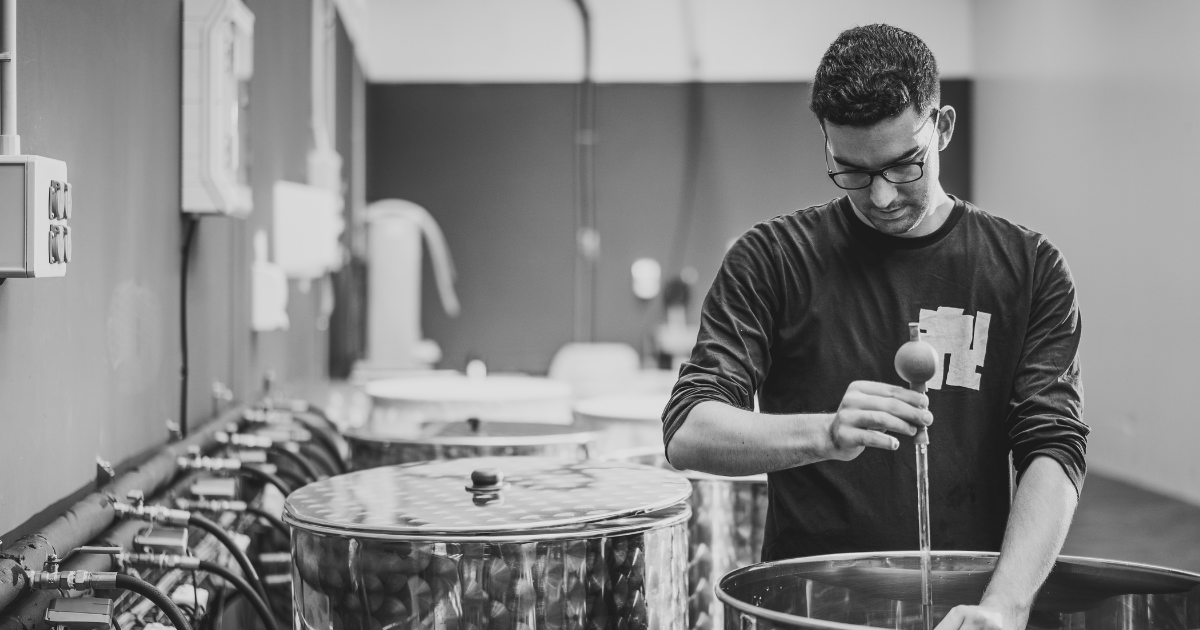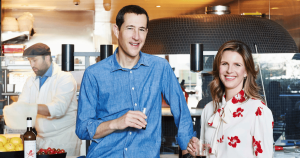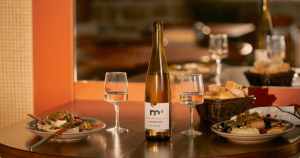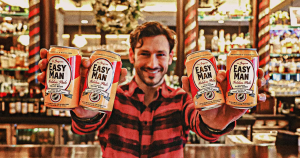Ama Brewery, renowned for its unique pét-nat teas, traces its roots back to the legendary fine dining restaurant Mugaritz. Born from the innovative culinary experiments of chefs Ramón Perisé and Dani Lasa, Ama began as a fascination with fermentation. Then, as the demand for no- and low- alcohol pairing menus grew, Ramón and Dani saw an opportunity to craft a fermented beverage that would complement fine dining experiences. Today, Ama’s intricate pét-nat teas are enjoyed in over 25 countries. Learn more about this journey from Aaron McAllister, Production Manager at Ama Brewery.
Ama was born from one of the best restaurants in the world. Tell us a bit about its origins.
Ama’s origins go back more than ten years to the R&D kitchens of Mugaritz, the legendary fine dining restaurant. While there, Ramón [Perisé – Ama’s Chef and Technical Director] purchased his first symbiotic culture of bacteria and yeast (SCOBY) from Germany. His initial interest was not in its liquid component but rather in the cellulose itself. He cured it in salt and sugar, grilled and dehydrated it, and—most notably—made it into an enormous edible tablecloth using an inflatable swimming pool in his colleague’s garage. The cellulose offered a novel product and texture with which he could experiment. The liquid, however, was more of a by-product, perhaps attractive as an alternative source for acidity in a dish, but not to be drunk by clients.
It was during the next few years that Ramón started to see a new trend in requests from guests, especially those from abroad: “less or no alcohol, please!” It was clear that times were changing, and Mugaritz needed options. Thus came the challenge that many restaurants now face: how do you create a non-alcoholic or low-alcohol pairing menu that isn’t perceived to be lower value than the traditional option? Fruit juices, infusions, and soft drinks may have their place in a particular context, but you cannot fill the entire experience with them. Therefore, they began to utilize fermentation to create complexity.
There is, however, a limit to what a restaurant is capable of doing in-house. Very few would attempt to regularly make their own wine or beer for lack of equipment, consistency, and space. Those same limitations also apply to the “novel” ferments.
So, how did the veterans of Mugaritz’s R&D team transition to creating their own line of pét-nat teas?
When Dani [Ama’s Chef and Executive Director] left the restaurant after 20 years as Head of R&D, he knew one of the projects he wanted to dedicate himself to was the solution to that problem: a complex, balanced no- or low-alcohol drink suitable for pairing in a gastronomic setting. Ramón, being the master of fermentation that he is, was the obvious partner to bring on to the project. From there, the project quickly developed.
The inspiration for the aged kombuchas came from the bottles that Ramón had produced and subsequently forgotten about. Then came Sancho Rodriguez, Ama’s Artisan Wine Maker, and countless trials to refine the recipe and methodology before we produced our first commercial bottles in 2019.
Our launch to market was auspiciously around the 15th of March, 2020, just before Spain and the wider world plunged into lockdown. As a product crafted for the high-end gastronomy sector, this was a particularly challenging time for us. Still, we survived, and now can be found in more than 25 countries and on the wine lists of many of the 50 Best.
How else has Ramón and Dani’s culinary expertise influenced Ama’s products?
Dani and Ramón’s background in the bleeding edge of gastronomy is fundamental to the success and vision for Ama. From discovering a method of aging a kombucha-based drink, which was previously thought impossible, to the flavor-first methodology that we apply to product development, and understanding how to create Amas for specific contexts—pairings, aperitifs, cocktails or more casual moments—their combined experience, along with Sancho from the winemaker side, is invaluable.
Too often in this sector, it becomes a paint-by-numbers exercise; each characteristic of the drink is forced to fit within very fine margins, stifling creativity and innovation at the cost of the quality of the end product. That can also damage the public perception of the category as a whole.
Our background in the gastronomy scene gives us more perspective from the points of view of the chef, the sommelier, and the interested drinker. That is hugely important if you want to create something special.
What inspired the Ama team to source teas from places like Taiwan, Malawi, and Japan?
Sourcing can be hugely challenging given the provenance of many of our raw materials. We would love to travel to every producer in the future to learn about their craft and story firsthand, but it’s challenging to do so. Fortunately, we are able to rely on some of the most prominent global tea experts to aid us in our search for exquisite teas that are sustainably cultivated, not only in terms of being organically produced, but also in terms of the distribution of the profits generated by the tea sales.
Our leading partner in that sourcing effort is Henrietta Lovell, founder of London’s Rare Tea Company, who has spent 20 years traveling to far-flung reaches of the globe to find these tiny tea gardens producing some of the most unique varieties. Our relationship is very dynamic; Henrietta will sometimes come to us with an exciting tea, or we will go to her with a particular flavor profile in mind.
The teas all have one thing in common: a great story and provenance—terroir.
Ama uses water sourced from the Alzola natural spring and the Izarraitz Massif mountain range. How important is the quality of water in the brewing process?
We had always been aware of the importance of the water quality used in the brewing of premium drinks. For years in the beer and sake industries, they have looked for precise mineral profiles to obtain the desired texture and nuanced notes in the final product. The extent of that selection’s importance, however, was very surprising to us.
Our drink is over 90% water, and we were clear from the start that we needed local spring water for Ama to ensure we have a root in our native Basque Country. It quickly became apparent that Alzola was the way forward for our brewing method. After 27 years of filtering through the limestone of the Izarraitz Massif, its unique mineral composition leads to the well-rounded mouthfeel and umami/seaweed notes one can often find in our bottles. If we were to use any other water, it wouldn’t be Ama.
Can you elaborate on the unique fermentation process that combines principles of kombucha production with the “méthode ancestrale” sparkling wine process?
The bottle-aging process we craft Ama with was, in part, an accidental discovery. Ramón had left bottles of a standard kombucha he had made with his chef partner, Elba, in a cupboard for a lot longer than intended. Upon returning to try them months later (and after cleaning up the ones that had exploded), he realized that this could be the potential route for the no/low alcohol beverage that he and Dani were developing. Well-integrated bubbles, not overly acidic or dry… the first-ever Pét-nat Tea.
Years of R&D to refine the recipe followed, until we could confidently replicate the process. This is the area in which we are still investing a great deal of time and resources to further understand.
The method is relatively simple: a primary fermentation using the SCOBY of the previous batch, which is then lightly filtered and bottled to be ready for aging. After five or six months of aging minimum, during which time they become naturally carbonated (hence Pét-nat) and develop much of their depth of flavor, we disgorge to reduce pressure, label, and then they hit the shelves!
Your teas have unique tasting notes like warm grapefruit, stone fruit jam, and seaweed. How do you achieve such complex flavors?
We have always intended for Ama to be the purest expression of those three components: tea (or herbs), water, and fermentation.
It’s a combination of selecting the correct teas for the job and how we transform them using fermentation and aging. Take HIRU, for example. The blend of the Malawi White Peony and Malawi Steamed Green teas, both from Satemwa, already have an extraordinary tropical aroma upon infusion. But after years of effectively “selectively breeding” our SCOBYs, including adapting them to the particular variety of tea or herb they are going to ferment, we can further extend that depth of flavor with many aromas and flavors appearing both during the primary and secondary fermentations.
However, certain notes are more likely due to the water we use. The characteristic umami or seaweed notes prevalent in our more austere varieties are thanks to the unique mineral composition of Alzola.
What has been the market response to your unique pét-nat teas, especially considering the growing trend towards tea-based beverages within the non-alc category?
As mentioned, we launched just before COVID closed our natural home in the gastronomy scene. However, during that period, many saw a significant shift in their relationship with alcohol consumption.
People now had a little more time to reevaluate their habits, and economic and social pressures led to many looking for a more focused, less intoxicating hedonistic experience. For Ama, one of the most premium drinks in that category, this was a boon. The statistics are clear: 80% of consumers in the UK, for example, want to reduce their alcohol intake, but they also do not want to sacrifice the quality of what they drink.
The challenge we at Ama Brewery face is visibility for what we do here. Restaurants, bars, events, and the public are all looking for quality options with little or no alcohol, and the big players are coming in with hefty marketing budgets for their wine or spirits alternatives, which we feel are generally not that exciting.
The no and low category, which is a very broad sphere of an increasingly less niche sector, will start to split between craft producers such as ourselves, Muri, Botivo, or REAL Drinks, and the players who ultimately have a different philosophy and approach.
Right now, we are all painted with the same brush, and our challenge will be to define the language and category for ourselves, whether below the no and low umbrella or something new.
In the future, we hope it will be completely normal to have one of Muri’s fermented blends, a glass of wine, a glass of Ama, and then finish off with some fantastic cocktail—no category, just flavor.
Are there any new flavors or types of tea you’re planning to introduce in the future?
We’ve got a hugely exciting limited edition collab ahead. It’s with a certain winemaker/tea-producing couple from Portugal—an Oolong that’s been aged in contact with the lees [residual yeast] from their port barrels. Absolutely amazing.
___
Dry Atlas is your guide to the world of alcohol alternatives. We maintain the world’s largest directory of non-alcoholic spirits, wines, beers, and more to help you discover options you’ll love. We also publish High Spirits, the weekly newsletter that helps open-minded drinkers like you learn more about non-alc. Our goal is to demystify alcohol alternatives so you can navigate them with ease to pursue a happier, healthier life.






